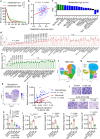Lactate dehydrogenase A regulates tumor-macrophage symbiosis to promote glioblastoma progression
- PMID: 38443336
- PMCID: PMC10914854
- DOI: 10.1038/s41467-024-46193-z
Lactate dehydrogenase A regulates tumor-macrophage symbiosis to promote glioblastoma progression
Abstract
Abundant macrophage infiltration and altered tumor metabolism are two key hallmarks of glioblastoma. By screening a cluster of metabolic small-molecule compounds, we show that inhibiting glioblastoma cell glycolysis impairs macrophage migration and lactate dehydrogenase inhibitor stiripentol emerges as the top hit. Combined profiling and functional studies demonstrate that lactate dehydrogenase A (LDHA)-directed extracellular signal-regulated kinase (ERK) pathway activates yes-associated protein 1 (YAP1)/ signal transducer and activator of transcription 3 (STAT3) transcriptional co-activators in glioblastoma cells to upregulate C-C motif chemokine ligand 2 (CCL2) and CCL7, which recruit macrophages into the tumor microenvironment. Reciprocally, infiltrating macrophages produce LDHA-containing extracellular vesicles to promote glioblastoma cell glycolysis, proliferation, and survival. Genetic and pharmacological inhibition of LDHA-mediated tumor-macrophage symbiosis markedly suppresses tumor progression and macrophage infiltration in glioblastoma mouse models. Analysis of tumor and plasma samples of glioblastoma patients confirms that LDHA and its downstream signals are potential biomarkers correlating positively with macrophage density. Thus, LDHA-mediated tumor-macrophage symbiosis provides therapeutic targets for glioblastoma.
© 2024. The Author(s).
Conflict of interest statement
The authors declare no competing interests.
Figures








Update of
-
LDHA-regulated tumor-macrophage symbiosis promotes glioblastoma progression.Res Sq [Preprint]. 2023 Oct 5:rs.3.rs-3401154. doi: 10.21203/rs.3.rs-3401154/v1. Res Sq. 2023. Update in: Nat Commun. 2024 Mar 5;15(1):1987. doi: 10.1038/s41467-024-46193-z. PMID: 37886538 Free PMC article. Updated. Preprint.
References
MeSH terms
Substances
Grants and funding
LinkOut - more resources
Full Text Sources
Molecular Biology Databases
Research Materials
Miscellaneous

